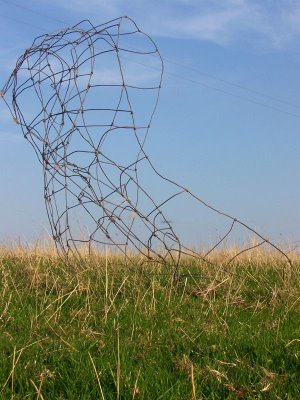Viewed from a variety of angles, ‘in the round’ as any 3D object should properly be appreciated to achieve a full sense of its form, the fence/drawing displays a pleasing combination of, & play between, horizontal & vertical elements, a free-flowing, open tracery of sensual, curving, delicate-yet-purposeful lines & more massive, scribbly agglomerations or ‘passages’, which gives it too a sense of energy & something of a dynamic quality suggestive of movement, of flow. The lines, of course, exist in three dimensions, creating interesting forms such as – dependent upon viewpoint - helix-like combinations of curves, loops & more severe, jagged peaks & aggressively twisted folds, these latter similar, indeed, to aspects of the landscape such as rock formations. Whatever, these accidental transformations wrought have something of a ‘rightness’ to them & bring this to the whole & an appreciation of it, as art (designated). Also present may be observed a certain 'measured', point-to-point or join-the-dots effect appropriate to drawing, courtesy of another of the fence’s physical features, the loops that serve to keep separate the individual squares of the design.
The whole, I think, has a certain elegance and aesthetic quality that transcends its damaged state & consequent removal from a functional context, & provides an interesting addition to the landscape of which it is an organically-evolving, interactive part (note the tufts of sheep’s wool adhering in places to the fence).
The images are presented in a sequence that intends to convey something of the experience of encountering the ‘drawing’ in the landscape, seen & composed in relation to other aspects of its surroundings such as telegraph poles & wires, trees, the long grass in which it resides & which constitute another element of pictorial ‘mark-making’, etc.












No comments:
Post a Comment